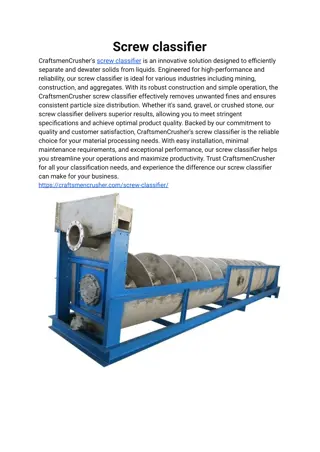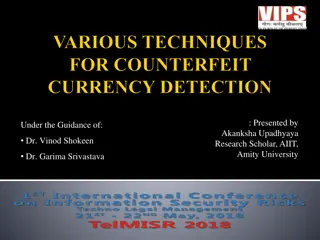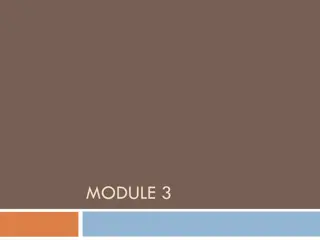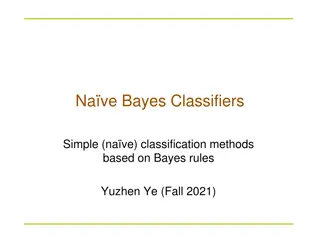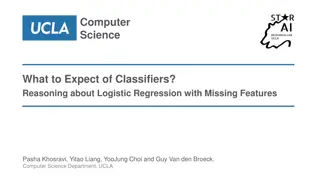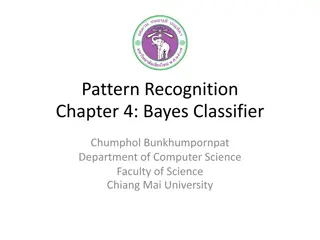
Efficient Sketching of Linear Classifiers over Data Streams
Explore the WM-Sketch methodology for training linear classifiers over data streams with limited memory while maintaining accuracy and adaptability to evolving patterns.
Uploaded on | 3 Views
Download Presentation

Please find below an Image/Link to download the presentation.
The content on the website is provided AS IS for your information and personal use only. It may not be sold, licensed, or shared on other websites without obtaining consent from the author. If you encounter any issues during the download, it is possible that the publisher has removed the file from their server.
You are allowed to download the files provided on this website for personal or commercial use, subject to the condition that they are used lawfully. All files are the property of their respective owners.
The content on the website is provided AS IS for your information and personal use only. It may not be sold, licensed, or shared on other websites without obtaining consent from the author.
E N D
Presentation Transcript
Sketching Linear Classifiers over Data Streams Presented by: Bhavya H S Kiran B R Kedarnath
INTRODUCTION What is this paper about? In today s data-driven world, we are constantly faced with massive streams of data emails, logs, transactions, social media posts, and more. This project explores how we can train and maintain a machine learning model (specifically, a linear classifier) over these data streams using very little memory, all while still being able to: Make accurate predictions in real time Explain which features (like words) influence decisions Adapt to evolving data patterns
PROBLEM STATEMENT The increase in real - time streaming data has created new challenges: Spam detection in emails and social media Real-time fraud and anomaly detection in finance and IOT Monitoring of network traffic and user behavior. These applications run on edge devices with limited memory Traditional classifiers like logistic regression are memory-intensive, especially in high-dimensional feature spaces Need for lightweight models that balance efficiency and interpretability
Traditional methods Traditional classifiers need to store full - weight vectors, which is infeasible on resource-constrained devices. 1. Feature Hashing Projects high-dimensional input features into a lower-dimensional space using a hash function. can't recover original features because of hash collisions 2. Simple Truncation Keep only the top-K largest weights and set the rest to zero Not memory-efficient during training ( need the full model first)
Traditional methods 3. Probabilistic Truncation Small weights might still be included based on a probability Still requires access to full weights during training 4. Count-Min Sketch Tracks how often each feature appears using hashed counters Only track frequencies, not weights 5. Space-Saving Keeps track of the most frequent items using a fixed-size heap Only track frequencies, not weights No support for gradient-based learning
Core Idea: WM Sketch Instead of storing millions of features with their weights use weight median sketch. Compress the model weights using a compact data structure. Supports online learning using gradient update. Allow to recover the most important features: Top K from memory.
Methodology Overview The WM-Sketch starts with a size-k array initialized to zero. This array is conceptually divided into s rows, each of width k/s. The sketch compresses the high-dimensional weight vector w from d-dimensional space into a much smaller k-dimensional space through hashing Two hash functions are used for each of the s rows. The first function maps the features from their original high-dimensional space to their respective buckets. The second function assigns a random sign (+1 or -1) to each feature
Methodology Overview The gradient is calculated as the derivative of the loss function with respect to the model weights. This tells us how to tweak the weights to increase or decrease the loss. the weights are updated by subtracting a fraction (defined by the learning rate) of the gradient. Regularization is performed to to prevent overfitting by penalizing large weights.
AWM-Sketch Variant The Active-Set Weight-Median Sketch (AWM-Sketch) is an enhancement of the basic Weight-Median Sketch (WM-Sketch) This variant introduces a dynamic component a heap (or active set ) to manage and track the most significant weights It separates the handling of the most impactful features from those less so, enabling more accurate predictions and efficient resource use.
Experimental Plan The evaluation for the performance of the proposed Weight-Median Sketch (WM-Sketch) and its variant, the Active-Set Weight-Median Sketch (AWM- Sketch), across several benchmark datasets. Datasets used: Reuters RCV1 Malicious URL Identification Algebra Dataset from KDD Cup 2010
Applications 1. Streaming Explanation Goal: Identify features that explain why certain data points stand out in a stream Example: Detecting outliers in sensor data (e.g., unusual time or location) Approach: Train a classifier to distinguish outliers vs. normal points Use classifier weights or relative risk to identify key features 2. Network Monitoring Goal: Identify significant differences in network traffic Example: Detecting abnormal patterns between source and destination IPs Approach: Frame as binary classification between streams Use learned weights to find high-ratio features
Applications 3. Streaming Pointwise Mutual Information (PMI) Goal: Estimate correlation between co-occurring events (e.g., word pairs) Example: NLP finding strongly associated word pairs ( San + Francisco ) Approach: Turn PMI estimation into a classification task Learn model weights that converge to PMI values Use AWM-Sketch to store weights compactly
Discussion and Key Insights 1. Active Set vs. Multiple Hashing Problem: High-weight features can collide in a bucket using multiple hashing. Active Set Solution: Add all features that hash to a heavy bucket into the active set. In correctly added features decay over time Automatically removed. High-weight features are retained Improves accuracy and disambiguation. 2. Cost of Interpretability AWM-Sketch improves classification accuracy compared to feature hashing. Why? Reduces collisions for heavily weighted features Better model clarity. Result: Higher accuracy without losing interpretability.
Discussion and Key Insights 3. Per-Feature Learning Rates Adjusting learning rates for individual features may improve performance. Challenge: Higher memory cost Needs to be explored further. 4. Multiclass Classification Maintain M copies of WM-Sketch (1 per class). For large M Computationally expensive. Solution: Use noise contrastive estimation to reduce complexity.
Conclusion Introduced Weighted-Median Sketch (WM-Sketch) for identifying high-weight features in streaming data. Achieved better weight recovery and competitive accuracy compared to baselines. Demonstrated strong performance on binary classification benchmarks. Reframed stream processing tasks as classification problems. Opens new opportunities in streaming analytics and machine learning.

